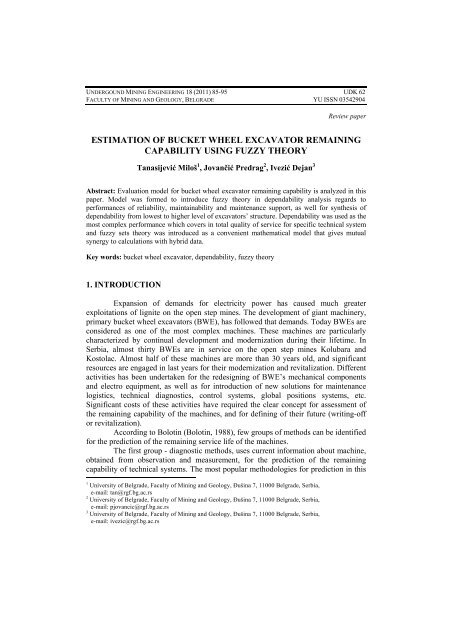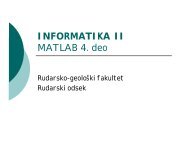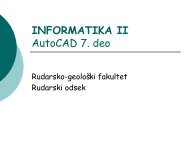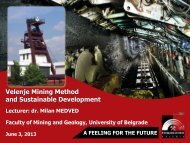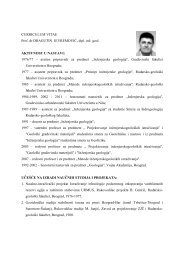estimation of bucket wheel excavator remaining capability using ...
estimation of bucket wheel excavator remaining capability using ...
estimation of bucket wheel excavator remaining capability using ...
You also want an ePaper? Increase the reach of your titles
YUMPU automatically turns print PDFs into web optimized ePapers that Google loves.
UNDERGOUND MINING ENGINEERING 18 (2011) 85-95 UDK 62FACULTY OF MINING AND GEOLOGY, BELGRADE YU ISSN 03542904Review paperESTIMATION OF BUCKET WHEEL EXCAVATOR REMAININGCAPABILITY USING FUZZY THEORYTanasijević Miloš 1 , Jovančić Predrag 2 , Ivezić Dejan 3Abstract: Evaluation model for <strong>bucket</strong> <strong>wheel</strong> <strong>excavator</strong> <strong>remaining</strong> <strong>capability</strong> is analyzed in thispaper. Model was formed to introduce fuzzy theory in dependability analysis regards toperformances <strong>of</strong> reliability, maintainability and maintenance support, as well for synthesis <strong>of</strong>dependability from lowest to higher level <strong>of</strong> <strong>excavator</strong>s’ structure. Dependability was used as themost complex performance which covers in total quality <strong>of</strong> service for specific technical systemand fuzzy sets theory was introduced as a convenient mathematical model that gives mutualsynergy to calculations with hybrid data.Key words: <strong>bucket</strong> <strong>wheel</strong> <strong>excavator</strong>, dependability, fuzzy theory1. INTRODUCTIONExpansion <strong>of</strong> demands for electricity power has caused much greaterexploitations <strong>of</strong> lignite on the open step mines. The development <strong>of</strong> giant machinery,primary <strong>bucket</strong> <strong>wheel</strong> <strong>excavator</strong>s (BWE), has followed that demands. Today BWEs areconsidered as one <strong>of</strong> the most complex machines. These machines are particularlycharacterized by continual development and modernization during their lifetime. InSerbia, almost thirty BWEs are in service on the open step mines Kolubara andKostolac. Almost half <strong>of</strong> these machines are more than 30 years old, and significantresources are engaged in last years for their modernization and revitalization. Differentactivities has been undertaken for the redesigning <strong>of</strong> BWE’s mechanical componentsand electro equipment, as well as for introduction <strong>of</strong> new solutions for maintenancelogistics, technical diagnostics, control systems, global positions systems, etc.Significant costs <strong>of</strong> these activities have required the clear concept for assessment <strong>of</strong>the <strong>remaining</strong> <strong>capability</strong> <strong>of</strong> the machines, and for defining <strong>of</strong> their future (writing-<strong>of</strong>for revitalization).According to Bolotin (Bolotin, 1988), few groups <strong>of</strong> methods can be identifiedfor the prediction <strong>of</strong> the <strong>remaining</strong> service life <strong>of</strong> the machines.The first group - diagnostic methods, uses current information about machine,obtained from observation and measurement, for the prediction <strong>of</strong> the <strong>remaining</strong><strong>capability</strong> <strong>of</strong> technical systems. The most popular methodologies for prediction in this1 University <strong>of</strong> Belgrade, Faculty <strong>of</strong> Mining and Geology, Đušina 7, 11000 Belgrade, Serbia,e-mail: tan@rgf.bg.ac.rs2 University <strong>of</strong> Belgrade, Faculty <strong>of</strong> Mining and Geology, Đušina 7, 11000 Belgrade, Serbia,e-mail: pjovancic@rgf.bg.ac.rs3 University <strong>of</strong> Belgrade, Faculty <strong>of</strong> Mining and Geology, Đušina 7, 11000 Belgrade, Serbia,e-mail: ivezic@rgf.bg.ac.rs
86 Tanasijević M.; Jovančić P.; Ivezić D.group use probability theory, the cumulative methods, semi-empirical methods,Markov chains or Poisson type models, and models based on examination with and/orwithout the destruction, as well as methods based to maintenance planning.The second group <strong>of</strong> methods primary uses economic indicators <strong>of</strong> machinesoperation, regardless to their working potential. The most popular methods in thisgroup are:- Methods for determination <strong>of</strong> the optimal machines life time based to economicvalidation (operation costs, present values, expected pr<strong>of</strong>it, etc.);- MAPI (Machinery and Allied Products Institute) analysis, that gives the answerto the question if it is more efficient to invest in replacement or revitalization andmodernization <strong>of</strong> machines;- Ford method which uses different economic indicators to find if the proposedredesign has the required technical characteristics, better than the existingsolutions.However, all previous methods require a series <strong>of</strong> data, technical and/oreconomic. BWEs are machines with a large working effects and their possiblestopping, for the implementation <strong>of</strong> diagnostic methods, causes additional costs.Economic indicators are mostly not objective, because these machines have beenoperated in non-market economy for almost the half <strong>of</strong> their service life. Even now,price <strong>of</strong> electricity, as an indirect product <strong>of</strong> BWEs, is partly subsidized by the Serbianstate. It can be concluded that, for the BWEs, as a systems with great investment value,great working performances and long working life, the existing methods forassessment the <strong>remaining</strong> <strong>capability</strong> can not provide quality results.Coefficient <strong>of</strong> time efficiency, i.e. ratio between up-time and total – calendartime, has been mainly used global criteria, i.e. indicator <strong>of</strong> BWE quality <strong>of</strong> service(Ivkovic et.al., 2004), (Jovančić et.al., 2008). However, this indicator has not beensuitable to find out the reasons for inadequate quality <strong>of</strong> service <strong>of</strong> BWE, to makedistinctions between downtimes due to problems in production management or BWEconstruction, or for identification <strong>of</strong> weak points in BWE structure. This can be veryimportant for defining the types <strong>of</strong> reconstruction actions.Dependability concept has been introduced through ISO-IEC standards(Standberg, 1991), (Tanasijević, 2007) as the most complete concept that describesavailability <strong>of</strong> considered technical system, i.e. presents the most complete quality <strong>of</strong>service measure. Implementation <strong>of</strong> dependability concept in essence includesinformation about system behaviors during up and down time concerning design andlogistic indicators (concrete information related to reliability, maintainability andmaintenance support).The problem, how to find “weak” components (with low dependability), at theBWE structure and reasons (design, maintenance, logistic) for their “weakness”, can bepractically resolved by evaluation <strong>of</strong> dependability. A model for dependabilityevaluation has been developed in research (Tanasijević, 2007), (Ivezić et.al., 2008).This model has been based on fuzzy sets theory (Klir & Yuan, 1995) and has tried tocompletely absorb expertise opinions and judgments given in linguistic forms.However, complex, hierarchical structure <strong>of</strong> BWE has not been treated by this model,and synthesis <strong>of</strong> the information from different hierarchical levels is not clear.
Estimation <strong>of</strong> <strong>bucket</strong> <strong>wheel</strong> <strong>excavator</strong> ... 87To overcome this problem, this paper presents a model for determining thedependability <strong>of</strong> <strong>excavator</strong>s based to fuzzy sets theory and fazzy algebra use. Fuzzysets are used for identification and integration <strong>of</strong> reliability, maintainability andmaintenance support performances to the dependability performance <strong>of</strong> singleelements, as well as for the synthesis <strong>of</strong> partial assessment <strong>of</strong> the dependability tohigher levels in the <strong>excavator</strong>s’ structure. Key role in the process <strong>of</strong> integration andsynthesis, is to define how the composition <strong>of</strong> partial impact to overall level. In thepaper max-min composition, also called pessimistic, is used. The idea is to makeoverall assessment equal to the partial virtual representative assessment. Thisassessment is identified as the best possible one between expected the worst partialgrades.2. EVALUTION OF DEPENDABILITYImplementation <strong>of</strong> dependability concept was developed in detail in IEC-300standards. The special attention was devoted to degree <strong>of</strong> customers’ satisfaction withappropriate product, by defining requirements for dependability, as well as to theconnection <strong>of</strong> producers and users organization. Dependability evaluation, inaccordance with this should enable the analysis <strong>of</strong> partial indicators (reliability,maintainability and maintenance support) and their synthesis. In that way, <strong>estimation</strong>for verification <strong>of</strong> achieved availability <strong>of</strong> technical systems is obtained.The first step in forming evaluations model is defining the hierarchicalstructure <strong>of</strong> technical systems, i.e. the decomposition <strong>of</strong> the system, in the case BWE.Excavator is considered as the four-level hierarchical structure (Durst & Vogt, 1986):component level, subsystem level, systems level and the highest level – <strong>excavator</strong>.Decomposition is performed based to construction – functional position. At the systemlevel next nine systems can be identified: Digging, Transport <strong>of</strong> material, Transport <strong>of</strong><strong>excavator</strong>, Boom lifting, Slewing <strong>of</strong> superstructure, Main structure, Accessorystructure, Control system and Electro supply. Other levels in the hierarchical structure<strong>of</strong> the <strong>excavator</strong> will not be listed on this site due to limited space. It should be notedthat the quality <strong>of</strong> the technical system evaluation largely depends on thedecomposition, and that it is necessary to perform decomposition to as lowconstruction levels as possible, but with clearly defined function.2.1. Analyses <strong>of</strong> dependabilityDependability performance <strong>estimation</strong> is obtained regards to analysis <strong>of</strong> itsindicators: reliability, maintainability and maintenance support. In order to identifyquality <strong>of</strong> elements in terms <strong>of</strong> reliability, it is necessary to define a fuzzy set, i.e.names (linguistic variables) and membership functions μ. Five fuzzy sets are propesed,with names: highly reliable, very reliable, averagely reliable, acceptable reliable,unreliable. As the measuring unit, can be introduced class, as usually used concept forrepresenting performances’ quality (1st to 7th, so is 1 highest quality class, ie. with thehighest reliability ...), for all three indicators. Hence, the structure <strong>of</strong> dependability
88 Tanasijević M.; Jovančić P.; Ivezić D.indicators and linguistic variables with seven classes as measures <strong>of</strong> appropriate fuzzysets will be as follows (Tanasijevic, 2007):1 , 2,..., nμ = μ μ μ , for n = 7 class( )R R R RR( )= ( 1 0; ...; 5 0; 6 0.25; 7 1unreliable)R( )=acceptable r.( 10;...;40;51;60.5;70)R( )=averagely r.( 1 0; 2 0; 3 0.5; 4 1; 5 0.5; 6 0; 7 0)R( )=very r.( 1 0; 2 1; 3 0.25; 4 0; ...; 7 0)R( )=highly r.( 1 1; 2 0.25; 3 0; ...; 7 0)Maintainability is primary concerned to system design accommodation tomaintenance actions. Generally, next five expressions <strong>of</strong> maintainability, aproposfuzzy sets, can be identified: optimal, easy, average, complicate and hard formaintenance. The position, shape and coverage <strong>of</strong> these linguistic variables, dependingon the class is given in form (Tanasijevic, 2007):1( , 2,..., n)μ = μ μ μ , for n = 7 classM M M MM =( ) ( 1 0; ...; 5 0; 6 0.25; 7 1hard)( ) ( 1 0; ...; 4 0; 5 0.5; 6 1; 7 0complicate)( ) ( 10;2 0;30.5;41;5 0.5;6 0;7 0average)( ) ( 1 0; 2 1; 3 0.5; 4 0;...; 7 0easy)( ) ( 1 1; 2 0.25; 3 0;...; 7 0optimal)M =M =M =M =By analysis <strong>of</strong> maintenance conditions that usually exist at Serbia lignitemines and also at complex industrial systems four maintenance support systems can beidentified: excellently developed well developed, limited and inexistence <strong>of</strong>maintenance support. The position, shape and coverage <strong>of</strong> these linguistic variables,depending on the class is given in form (Tanasijevic, 2007):1 , 2,..., nμ = μ μ μ , for n = 7 class( )L L L LL =( ) ( 10;...;50;60.25;71inexistence)( ) ( 10;20;30;40.5;51;60.5;70limited)( ) ( 10;20.5;31;40.5;50;60;70well developed)L =L =L( )=excellently dev.( 1 1; 2 0.75; 3 0; ...; 7 0)The next step is a synthesis <strong>of</strong> <strong>estimation</strong> for reliability R, maintainbility Mand maintenance support L to the level <strong>of</strong> dependability D. Synthesis is done based onthe corresponding fuzzy compositions. In the case "max-min" composition (Wanget.al., 1995) is used, defined as follows:D = R M × L(1)
Estimation <strong>of</strong> <strong>bucket</strong> <strong>wheel</strong> <strong>excavator</strong> ... 89Cartesian product (and the corresponding membership function) <strong>of</strong> two setsM x L as an indicator related to maintenance, i.e. related to the period while the systemis out <strong>of</strong> operation, is defined as follows:ijμM× L= ( μM×L)(2)n × nwhere is:ij i jμM × L= min ( μM,μL)(3)Finally, the membership functions for the set D can be obtained as follows:jμD = μRo M×L= ( μD) (4)1 × nwhere is:jmax ( min ( ) ( ))1 , 1 j n njμD= μRμM× L,..., min μR, μM×L, j = 1,2,..., n (5)Thus defined "max-min" composition, locates the fuzzy set L as the "critical",in other words, in the case that some element <strong>of</strong> <strong>excavator</strong> has high reliability R andmaintenance support L, dependability D rating will also be low.As the output <strong>of</strong> fuzzy composition, dependability <strong>of</strong> elements is obtained inthe form related to classes, as:1( , 2,..., nμD = μDμDμD), orD = (1/(0...1.0), 2/(0...1.0), 3/(0...1.0), 4/(0...1.0), 5/(0...1.0), 6/(0...1.0), 7/(0...1.0))In relation to the class (1 to 7) dependability and their membership functionscan be defined as: excellent, good, average and poor:D = 1 0; ...; 5 0; 6 0.75; 7 1( poor) ( )( ) ( 1 0; 2 0; 3 0; 4 0.5; 5 1; 6 0.25; 7 0average)( ) ( 1 0; 2 0.25; 3 1; 4 0.5; 5 0; 6 0; 7 0good)( ) ( 1 1; 2 0.75; 3 0; ...; 7 0excellent)D =D =D =Dependability can be identified (Tanasijević, 2010) according to thedependability fuzzy sets by center <strong>of</strong> mass point calculation Z:7∑ μC⋅Cii=1Z = = 1...7(6)7μ∑i=1Ciwhere is C class (1 to 7), μ C membership funtion to the intersection <strong>of</strong> number Z andclass C.2.2. Synthesis <strong>of</strong> dependabilityFor the synthesis <strong>of</strong> membership functions μ Dfuzzy algebra, i.e. max-mincomposition can be used. If the membership functions D <strong>of</strong> the elements are observed,the possible combinations <strong>of</strong> the fuzzy sets <strong>of</strong> dependability can be identified and foreach <strong>of</strong> them the outcome can be determined. It is customary to use the ''IF-THEN''
90 Tanasijević M.; Jovančić P.; Ivezić D.rules. E.g. IF all the elements <strong>of</strong> the partial evaluation are ''excellent'', THEN theoutcome <strong>of</strong> a set <strong>of</strong> elements (at higher hierarchical level) is ''excellent''. In the casethat a combination <strong>of</strong> different elements assessments is occurred, average assessmentshould be calculated and determination <strong>of</strong> outcome should be done based to it. Maxmincomposition is then applied as follows:- for each combination, search for the MINimum value <strong>of</strong> the intersection <strong>of</strong>dependability fuzzy sets and the value <strong>of</strong> the Z for each element;- for each <strong>of</strong> the outcomes find the MAXimum between previously identifiedminimums;- finally, the maximum value is normalized to 1.In this way, the assessment <strong>of</strong> dependability for set <strong>of</strong> elements is obtained asfollows:D = (( μ 1 , ''poor''), (μ 2 , ''average''), (μ 3 , ''good''), (μ 4 , ''excellent''))3. CASE STUDY: EXCAVATOR SCHRS 630,KOLUBARA – TAMNAVA WEST FIELDAs an application example <strong>of</strong> developed methods for dependabilitydetermination, analysis <strong>of</strong> BWE (first level <strong>of</strong> <strong>excavator</strong>s decomposition) will bepresented, as well as the synthesis to the level <strong>of</strong> <strong>excavator</strong>. These systems will beconsidered as elements, and <strong>excavator</strong> as a technical system. Estimations are obtainedas experts’ by the staff employed operation and maintenance.1. System for digging:Reliability <strong>of</strong> the system for digging was evaluated in inquiry as very reliableby all engineers (100%). However, two <strong>of</strong> them (20%) selected also averagely reliable.In accordance with fuzzy sets R, gets the evaluation <strong>of</strong> the reliability <strong>of</strong> the system fordigging, as given in Table 1Table 1. Procedure <strong>of</strong> reliability evaluation <strong>of</strong> digging systemLinguistic % <strong>of</strong> Classvariable respondents 1. 2. 3. 4. 5. 6. 7.Very 100% 0x100% 1.0x100% 0.5x100% 0x100% 0x100% 0x100% 0x100%Average 20% 0x20% 0x20% 0.5x20% 1.0x20% 0.5x20% 0x20% 0x20%ΣR 1 0 1,0 0,6 0,2 0 0 0R 1 = (1/0, 2/1.0, 3/0.6, 4/0.2, 5/0, 6/0, 7/0)In the same way the maintainability and maintenance support are rated, forsystem for digging:M 1 = (1/0, 2/1.0, 3/0.5, 4/0.1, 5/0, 6/0, 7/0), L 1 = (1/0, 2/0, 3/0.1, 4/0.5, 5/1.0, 6/0.4, 7/0)Max-min composition is expressed as follows:ijμ = μ( ) 7 × 7M× L M×L
Estimation <strong>of</strong> <strong>bucket</strong> <strong>wheel</strong> <strong>excavator</strong> ... 91⎡00 0 0 0 0 0⎤⎢0 0 0.1 0.5 1.0 0.4 0⎥⎢⎥⎢0 0 0.1 0.5 0.5 0.4 0⎥ij j j ⎢⎥μM×L= min ( μM, μL)= ⎢ 000.10.10.10.10 ⎥⎢00 0 0 0 0 0⎥⎢⎥⎢00 0 0 0 0 0⎥⎢00 0 0 0 0 0⎥⎣⎦j 1 1 jmax min , ,...,min 7 ,7 jμ = μ μ μ μ( ( × ) ( × ))j( ) ( 0; 0; 0.1; 0.5;1.0; 0.4; 0)D R M L R M Lj=1,...,7μD = μR o M×L= μD=17 ×Dependability for the system for digging is finally obtained in the form:1 ( 10;2 0;3 0.1;4 0.5;51.0;6 0.4;7 0)D =2. System materials' transport2 ( 1 0.8; 2 1.0; 3 0.1; 4 0; 5 0; 6 0; 7 0)R =M2= ( 11.0;2 0.6;3 0;4 0;5 0;6 0;7 0)L2= ( 1 0.7; 2 1.0;3 0.3; 4 0;5 0;6 0;7 0)D2= ( 1 0.7; 2 0.8; 3 0.3; 4 0; 5 0; 6 0; 7 0)3. System for <strong>excavator</strong>'s transport3 ( 10;2 0.3;3 0.7;41.0;5 0.2;6 0;7 0)R =M3= ( 10;21.0;3 0.4;4 0.1;5 0;6 0;7 0)L3= ( 1 0; 2 0.3; 3 1.0; 4 0.5; 5 0.2; 6 0; 7 0)D3= ( 10;2 0.3;3 0.4;4 0.4;5 0.2;6 0;7 0)4. Boom lifting4 ( 1 0.2; 2 1.0;3 0.4; 4 0;5 0;6 0; 7 0)R =M4= ( 1 0.1; 2 1.0;3 0.6; 4 0;5 0;6 0;7 0)L4= ( 1 0.1; 2 0.6; 3 1.0; 4 0.2; 5 0; 6 0; 7 0)D4= ( 1 0.1; 2 0.6; 3 1.0; 4 0.2; 5 0; 6 0; 7 0)5. Slewing <strong>of</strong> superstructure5 ( 1 0; 2 1.0; 3 0.7; 4 0.4; 5 0.1; 6 0; 7 0)R =M5= ( 10;21.0;3 0.7;4 0.3;5 0;6 0;7 0)L5= ( 1 0; 2 0.4; 3 1.0; 4 0.4; 5 0.1; 6 0; 7 0)D5= ( 10;2 0.4;31.0;4 0.4;5 0.1;6 0;7 0)
92 Tanasijević M.; Jovančić P.; Ivezić D.6. Main structure6 ( 1 0.1; 2 1.0; 3 0.5; 4 0.1; 5 0; 6 0; 7 0)R =M6= ( 1 0.3; 2 1.0;3 0.3; 4 0;5 0;6 0; 7 0)L6= ( 1 1.0; 2 0.7; 3 0.1; 4 0; 5 0; 6 0; 7 0)D6= ( 1 1.0; 2 0.7; 3 0.1; 4 0; 5 0; 6 0; 7 0)7. Accessory structure7 ( 1 0.2; 2 1.0;3 0.5; 4 0;5 0;6 0;7 0)R =M7= ( 1 0.3; 2 1.0;3 0.3; 4 0;5 0;6 0;7 0)L7= ( 11.0;2 0.7;3 0.1;4 0;5 0;6 0;7 0)D7= ( 1 1.0; 2 0.7; 3 0.1; 4 0; 5 0; 6 0; 7 0)8. Electr control8 ( 11.0;2 0.25;3 0;4 0;5 0;6 0;7 0)R =M8= ( 11.0;2 0.25;3 0;4 0;5 0;6 0;7 0)L8= ( 1 1.0; 2 0.75; 3 0; 4 0; 5 0; 6 0; 7 0)D8= ( 11.0;2 0.75;3 0;4 0;5 0;6 0;7 0)9. Electro supply9 ( 11.0;2 0.25;3 0;4 0;5 0;6 0;7 0)R =M9= ( 1 1.0; 2 0.25; 3 0; 4 0; 5 0; 6 0; 7 0)L9= ( 11.0;2 0.75;3 0;4 0;5 0;6 0;7 0)D9= ( 11.0;2 0.75;3 0;4 0;5 0;6 0;7 0)In the second step <strong>of</strong> synthesis, Z values are calculated for each n = 9 systems:7∑ μC⋅Cii=10 ⋅ 1+ 0⋅ 2 + 0.1⋅ 3 + 0.5⋅ 4 + 1.0⋅ 5 + 0.4⋅ 6 + 0⋅7Z1 = = = 4.8570 + 0 + 0.1+ 0.5 + 1.0 + 0.4 + 0μ∑i=1CiZ2 = 1.78; Z3 = 3.38; Z4 = 2.68; Z5 = 3.11; Z6 = 1.50; Z7 = 1.50; Z8 = 1.43; Z8= 1.43They are further presented depending on the fuzzy sets D, and the value <strong>of</strong>membership functions μ(D) are read for the intersection point <strong>of</strong> Z values andcorresponding reliability fuzzy sets (Table 2).
Estimation <strong>of</strong> <strong>bucket</strong> <strong>wheel</strong> <strong>excavator</strong> ... 93Table 2. Intersections <strong>of</strong> dependability fuzzy sets and center <strong>of</strong> mass point for <strong>excavator</strong>systemsCenter<strong>of</strong> massZ 1 Z 2 Z 3 Z 4 Z 5 Z 6 Z 7 Z 8 Z 9Fuzzy setPoorAverage 1.0000Good 0.0833 1.0000 0.7632 1.0000Excellent 0.9167 0.2368 1.0000 1.0000 1.0000 1.0000On the basis <strong>of</strong> defined intersections, four combinations <strong>of</strong> <strong>estimation</strong>s fornine systems <strong>of</strong> <strong>excavator</strong>s are realistic, and the expected outcomes are (Table 3):Table 3. Outcomes by fuzzy sets combinations <strong>of</strong> dependability for <strong>excavator</strong>systemsSystemComb.1. 2. 3. 4. 5. 6. 7. 8. 9. Outcomes1. A G G G G E E E E G2. A E G G G E E E E G3. A G G E G E E E E G4. A E G E G E E E E EIn the table, assessments are marked by letters (E - excellent, etc..), andoutcomes are determined by allocation <strong>of</strong> numerical value to each linguistic evaluation(excellent = 4, good = 3, etc..), average evaluation is:2+ 3+ 3+ 3+ 3+ 4+ 4+ 4+4I = = 3.33 , belong to outcome ″good″;1. comb.9I2. comb. = 3.44 → good;I3. comb. = 3.44 → good;I = → excellent.4. comb. 3.55Application <strong>of</strong> max-min composition is shown in Table 4:Table 4. Structure <strong>of</strong> max-min composition for thesynthesis <strong>of</strong> the system <strong>of</strong> <strong>excavator</strong>Outcome P A G ECombinationMIN for outcome1. 0 0 0.0833 02. 0 0 0.7632 03. 0 0 0.0833 04. 0 0 0 0.2368MAX 0 0 0.7632 0.2368Normal. 0 0 0.7632 0.2368
94 Tanasijević M.; Jovančić P.; Ivezić D.In this way, assessment <strong>of</strong> dependability <strong>of</strong> <strong>bucket</strong> <strong>wheel</strong> <strong>excavator</strong> SchRs 630is: D (B.W.E) = ((0, ''poor''), (0, ''average''), (0.7632, ''good''), (0.2368, ''excellent''))For the observed <strong>excavator</strong> can be said that his Dependability in large measureon the 76% good, and that to that extent be expected to have sufficient <strong>remaining</strong>capabilities.4. CONCULSIONExposed mathematical and conceptual model <strong>of</strong> <strong>excavator</strong>s’ dependabilityevaluation, based to fuzzy theory, has been tried to fully absorb all the influentialfactors on the <strong>remaining</strong> capabilities these machine. Thereby, evaluation <strong>of</strong> the<strong>remaining</strong> capabilities was done by dependability’ assessment. Dependability is overallindicator for quality <strong>of</strong> service, and considers simultaneously reliability,maintainability and maintenance support. As <strong>bucket</strong> <strong>wheel</strong> <strong>excavator</strong> is a technicalsystem with a complex hierarchical structure, synthesis <strong>of</strong> information given in fuzzyform from the level <strong>of</strong> components to subsystems, functional systems and whole<strong>bucket</strong> <strong>wheel</strong> <strong>excavator</strong> is necessary.This fuzzy form is found as the most suitable for introduction <strong>of</strong> knowledge andexperiences accumulated during BWE design, operation and maintenance, as well asrelated to BWE structure and its logistic characteristics. Presented model can be used as asimple tool for fast <strong>estimation</strong> <strong>of</strong> dependability and <strong>remaining</strong> <strong>capability</strong> also, for BWE,based to experts’ judgments. The model is shown in detail on the <strong>excavator</strong> SchRs 630.Proposed model can easily be used for quality <strong>of</strong> service assessment for other technicalsystems with complex hierarchical structure.REFERENCES[1] Bolotin, V.V., [1988]: Prediction <strong>of</strong> Service Life for Machines andStructures, American Society <strong>of</strong> Mechanical Engineers, USA.[2] Durst, W., Vogt, W., [1986]: Bucket <strong>wheel</strong> <strong>excavator</strong>s, Trans TechPublications, Clausthal.[3] Ivezić, D., Tanasijević, M., Ignjatović, D., [2008]: Fuzzy Approach toDependability Performance Evaluation, Quality and Reliability EngineeringInternational, Vol. 24 (7), 779-792.[4] Ivković, S., Ignjatović, D., Tanasijević, M., Ivković, D., [2004]: Ponašanjerotornih bagera u eksploataciji na površinskim kopovima uglja u Srbiji irizici, 12. savetovanje sa međunarodnim učešćem ″Upravljanje rizicima,preventiva i osiguranje u energetici″, Dunav PREVING a.d., Beograd, 199-204.[5] Jovančić, P., Ignjatović, D., Tanasijević, M., Maneski, T., [2008]:Dijagnostikovanje stanja i ponašanja rotornih bagera u cilju njihoverevitalizacije, Tehnika - Rudarstvo, geologija i metalurgija, Vol. 59(3), 9-18.[6] Klir, G. J., Yuan, B., [1995]: Fuzzy Sets and Fuzzy Logic, Theory andApplications, Prentice Hall, New York.
Estimation <strong>of</strong> <strong>bucket</strong> <strong>wheel</strong> <strong>excavator</strong> ... 95[7] Strandberg, K., [1991]: IEC 300: the dependability counterpart <strong>of</strong> ISO 9000,In Reliability and Maintainability Symp, Orlando, FL.[8] Tanasijević, M., [2007]: Sigurnost funkcionisanja mehaničkih komponentirotornog bagera, Doktorska disertacija, RGF, Beograd.[9] Tanasijević, M., Ivezić, D., Jovančić, P., [2010]: Ocena sigurnostifunkcionisanja rotornog bagera korišćenjem pravila fazi algebre, Integritet ivek konstrukcija, Vol.10(1), 43-52.[10] Wang, J., Yang, J. B., Sen, P., [1995]: Safety analyses and synthesis <strong>using</strong>fuzzy sets and evidential reasoning, Reliability Engg & Syst Safety, 47, 103-118.


